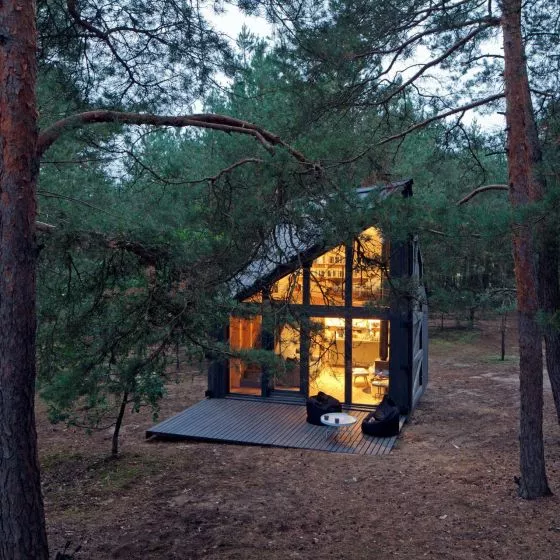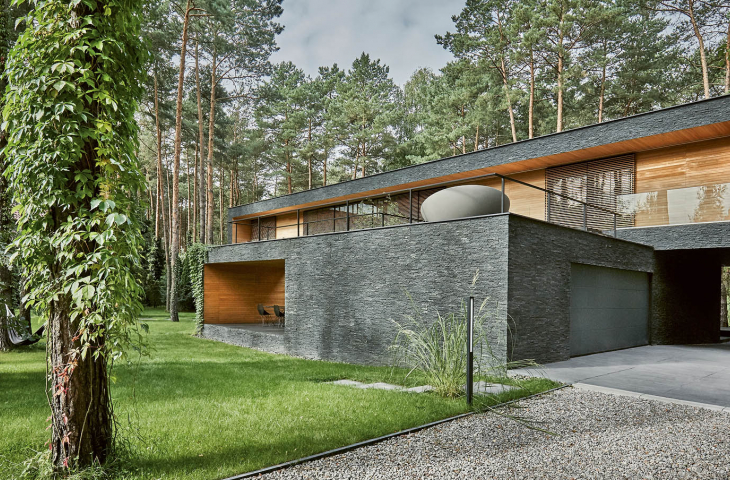Realizations
Katarzyna: How many houses of your project have already entered the wetap of realization or have been completed?
Rafal: In a dozen customers already live, the gardens are developed. Another fifteen are under construction, and we have twenty-five at the design stage.
Anna: This is a very long process, it takes four or even five years. We had to wait three or four years each for the first buildings to be completed, and then some more until the gardens are landscaped, the interiors finished. Now we are at the point where we have continuity.
Rafal: It also happened once that a building didn't get built. The husband brought his wife and said he wanted a modern house, and the wife said she wanted a manor house. We said that we don't do mansions, and the husband said that he had just brought her to convince her to do something modern. We designed a modern block, he liked it very much, and his wife didn't like it at all. He tried to convince her, but failed. The cooperation ended with the concept.
Anna: Sometimes it's the case that people are not one hundred percent in agreement about expectations. The trick is to find the golden mean, and not to side with one of these people, because the other person will not feel comfortable in such a house. You have to be a psychologist sometimes and get to the point where everyone is happy - the people who come for the project will be happy with the result, and we will create a project that we will be happy to continue. It's usually the case that men want a little more modern design, and women prefer warmth. It seems to the husband that if the studio persuades his wife, it will be easier for him and he will succeed in realizing a house in accordance with his expectations. Sometimes it actually goes that way.
Catherine: You said "we don't do mansions". Are there any other rules that you adhere to?
Rafal: We are primarily approached by clients who have chosen us themselves, so they know what to expect. We don't specialize in mansions, but in modern solids.
Anna: We don't want to do what someone shows us. We say directly that if someone likes a design from a catalog, let him buy it. He will spend less money and will be satisfied. We won't do something based on a design. We want to smuggle our ideas into it all.
The main entrance to the house; through the glazing you can see the single flight staircase to the first floor; on the first floor through the blinds you can see the skylight
Photo: Bartek Zaranek © 81.WAW.PL
Katarzyna: It happens that someone would like to copy not some house, but one of the houses designed by you? Do you allow this?
Rafal: Not either. We have an example: a client came to us, showed us a house and said he wanted one. We said that we couldn't do one like that, because we were bound by the contract with the previous client, but that we could do something of a similar nature. That's how the Black-on-White House was created. It too was supposed to be dynamic and bold, and it turned out to be bolder than the original - the Trapezoid House. They have one thing in common: they are two blocks that are staggered in relation to each other, while materially and functionally they are different. The client is just finishing building this house, he found this design much better than the one he came with.
Katarzyna: To conclude, let's go to the macro scale: how do your projects, and more generally, how is it now built in Poland, fit in with world architecture? Do regionalisms dominate?
Rafal: We have clients who live in Portugal, we are designing a housing estate for them. They told us that there they like thin ceilings, thin overhangs, and they would like to transfer something like that to Poland. In our country it's not quite possible to do it, because you have to wrap everything with Styrofoam, which is fifteen centimeters on one side and on the other. Technological solutions are different for a given climate zone.
Anna: In Switzerland, modern buildings are often constructed of concrete and the interiors are low, which may be due to the climate and the need for heating. In Spain, construction is all white because of the sunshine. In the United States, houses are spread out, poised, with patios. There, it's not so much the exterior facade that's important, but rather the carving up of the house from the inside.
Rafal: Glazing used to be feared in Poland because of energy losses. Now the heat transfer coefficient of windows is very good, not so much of it escapes anymore, and it looks great, you can open up to the surroundings. It used to be said that large glazing is only in Florida or Spain. We can do the same thing here, technology allows us to do it.
Catherine: The only thing left is washing those windows.
Rafal: Everyone talks about washing. They repeat: "And who is going to wash it?" There are Kärcher washers that allow you to clean the windows in thirty minutes. This is another element that convinces people. Our office on the water has a "mirror" facade. I give this as an example that even such a facade can be washed very quickly on its own. All it takes is the right and simple solution. Just like in design. It's always about a simple and obvious idea.
interviewed: {tag:AuthorAiB}




























































